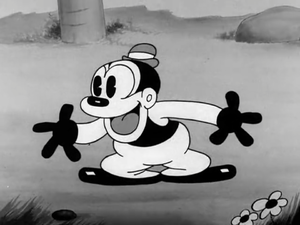Bosko
| WARNING! This article contains content that may not be seen as age appropriate or upsetting for some readers. It may contain references to blackface and outdated racial stereotypes. Reader discretion is advised. |
| Bosko | |
|---|---|
 | |
| Species | Human Dog in Tiny Toon Adventures |
| Gender | Male |
| First appearance | Bosko, the Talk-Ink Kid (1929) |
| Played by | Carman Maxwell (1929-1930) Bernard B. Brown (1930-1932) Johnny Murray (1931–1933) Don Messick (1990) |
| File:TTA Bosko.png Tiny Toon Adventures | |
Bosko is an animated character created by animators Hugh Harman and Rudolf Ising. He was the first recurring star of the Looney Tunes theatrical cartoon series, and appeared in a total of thirty-nine shorts. His voice was originated by Carman Maxwell, then by various others through the 1930s.
Character description
Bosko is generally portrayed as a cheerful character who exudes a mischievous, playful attitude. As with many cartoon characters of his era, including Disney's Mickey Mouse, Bosko often engages into song and dance numbers, and is shown to have a strong, flexible body. He also wears a derby hat and long pants. Bosko's girlfriend is Honey, who also shares a similar jovial personality.
Visually, Bosko resembles those of blackface minstrel characters, which reflected racial stereotypes that were common at the time. He was meant to be a cartoony version of Al Jolson in the 1927 film The Jazz Singer, though according to Rudolf Ising, he was initially supposed to be an "inkspot sort of thing." He was not conceived as either a human or animal, though he was meant to behave like a little boy.[1] Bosko initially spoke in a Southern dialect of African American Vernacular English, though this was later drop for his later appearances in the Looney Tunes shorts.
In Tiny Toon Adventures, he is portrayed as an anthropomorphic dog, presumably due to concerns regarding his original blackface characterization.
Appearances
TV series
- Tiny Toon Adventures
- 1x30 "Field of Honey"
- 3x09 "Two-Tone Town"
- Animaniacs
- 3x11b "The Girl with the Googily Goop" (cameo)
Movies
- Space Jam (portrait only)
Shorts
- Bosko, the Talk-Ink Kid
- Looney Tunes
- Sinkin' in the Bathtub
- Congo Jazz
- Hold Anything
- The Booze Hangs High
- Boxcar Blues
- Big Man from the North
- Ain't Nature Grand!
- Ups 'N Downs
- Dumb Patrol
- Yodeling Yokels
- Bosko's Holiday
- The Tree's Knees
- Bosko Shipwrecked!
- Bosko the Doughboy
- Bosko's Soda Fountain
- Bosko's Fox Hunt
- Bosko at the Zoo
- Battling Bosko
- Big-Heated Bosko
- Bosko's Party
- Bosko and Bruno
- Bosko's Dog Race
- Bosko at the Zoo
- Bosko's Store
- Bosko the Lumberjack
- Ride Him, Bosko!
- Bosko the Drawback
- Bosko's Dizzy Date
- Bosko's Woodland Daze
- Bosko in Dutch
- Bosko in Person
- Bosko the Speed King
- Bosko's Knight-mare
- Bosko the Sheep-Herder
- Beau Bosko
- Bosko's Mechanical Man
- Bosko the Musketeer
- Bosko's Picture Show
Biography
Original Shorts
| This article or section is a stub. You can help the Looney Tunes Wiki by expanding it. |
We're All a Little Looney
| This article or section is a stub. You can help the Looney Tunes Wiki by expanding it. |
Development
| This article or section is a stub. You can help the Looney Tunes Wiki by expanding it. |
In his book, Of Mice and Magic, Leonard Maltin states the early portrayal of Bosko with the following text:
"Bosko was in fact a cartoonized version of a young black boy. […] he spoke a South Negro dialect, but in subsequent films this characterization was eschewed—or perhaps forgotten. This could be called sloppiness on the part of Harman and Ising, but it also indicates the uncertain nature of the character itself.[2]
Gallery
- Main article: Bosko/Gallery
Behind the scenes
References
- ↑ Lindvall, Terry; Fraser, Ben (1998), "Darker Shades of Animation: African-American Images in the Warner Bros. Cartoon" (p. 125-126), in Sandler, Kevin S., Reading the Rabbit: Explorations in Warner Bros. Animation. Rutgers University Press, ISBN 978-0813525389.
- ↑ Maltin, Leonard (1987). Of Mice and Magic: A History of American Animated Cartoons, p. 225. Penguin Books. ISBN: 978-0452259935.